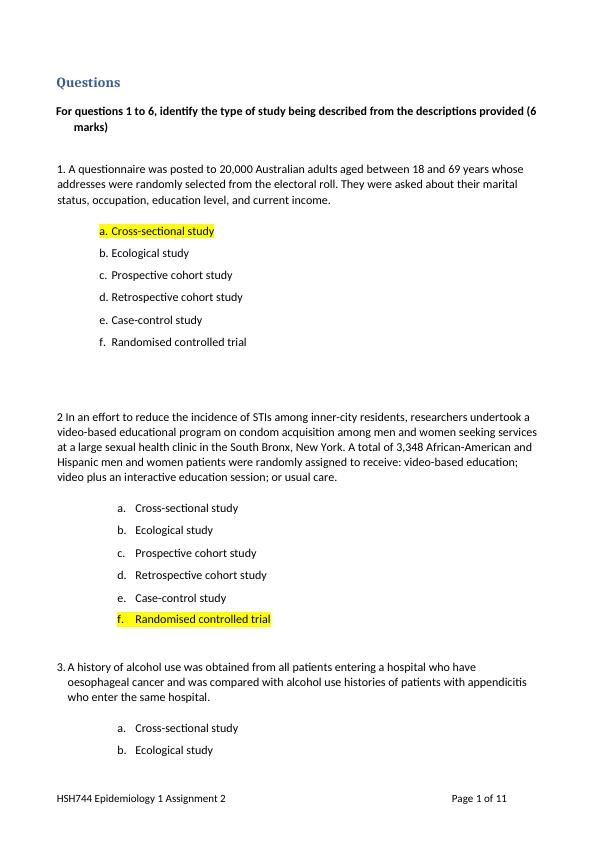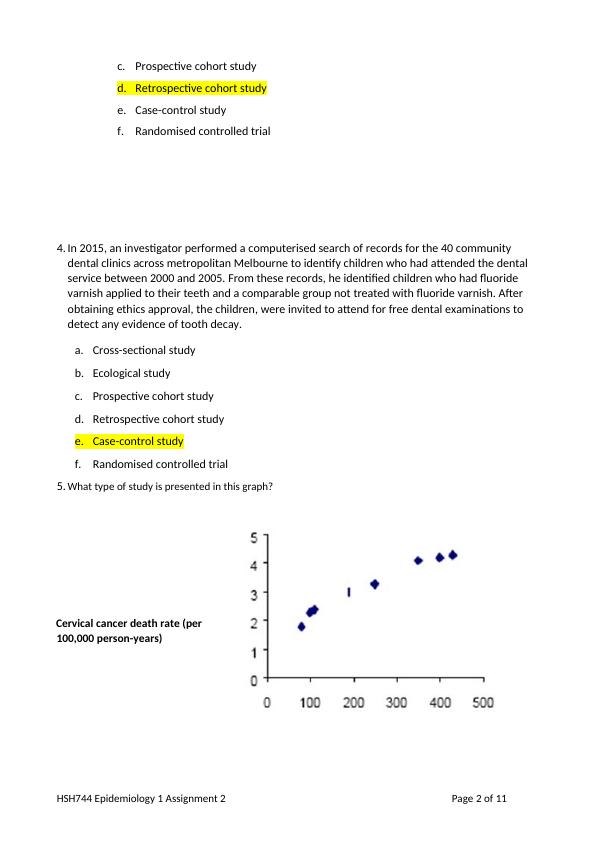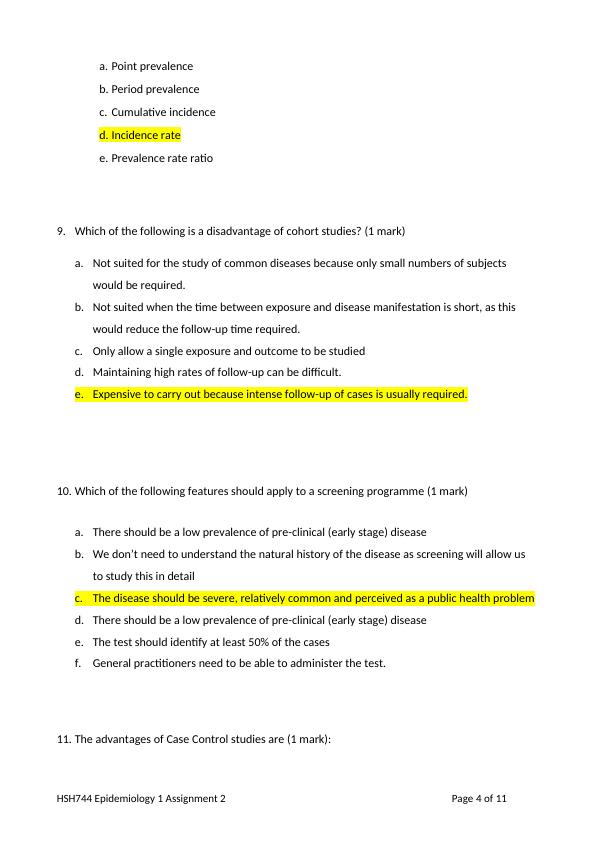Identifying Types of Study Designs
Added on 2023-03-17
11 Pages2896 Words94 Views
Questions
For questions 1 to 6, identify the type of study being described from the descriptions provided (6
marks)
1. A questionnaire was posted to 20,000 Australian adults aged between 18 and 69 years whose
addresses were randomly selected from the electoral roll. They were asked about their marital
status, occupation, education level, and current income.
a. Cross-sectional study
b. Ecological study
c. Prospective cohort study
d. Retrospective cohort study
e. Case-control study
f. Randomised controlled trial
2 In an effort to reduce the incidence of STIs among inner-city residents, researchers undertook a
video-based educational program on condom acquisition among men and women seeking services
at a large sexual health clinic in the South Bronx, New York. A total of 3,348 African-American and
Hispanic men and women patients were randomly assigned to receive: video-based education;
video plus an interactive education session; or usual care.
a. Cross-sectional study
b. Ecological study
c. Prospective cohort study
d. Retrospective cohort study
e. Case-control study
f. Randomised controlled trial
3. A history of alcohol use was obtained from all patients entering a hospital who have
oesophageal cancer and was compared with alcohol use histories of patients with appendicitis
who enter the same hospital.
a. Cross-sectional study
b. Ecological study
HSH744 Epidemiology 1 Assignment 2 Page 1 of 11
For questions 1 to 6, identify the type of study being described from the descriptions provided (6
marks)
1. A questionnaire was posted to 20,000 Australian adults aged between 18 and 69 years whose
addresses were randomly selected from the electoral roll. They were asked about their marital
status, occupation, education level, and current income.
a. Cross-sectional study
b. Ecological study
c. Prospective cohort study
d. Retrospective cohort study
e. Case-control study
f. Randomised controlled trial
2 In an effort to reduce the incidence of STIs among inner-city residents, researchers undertook a
video-based educational program on condom acquisition among men and women seeking services
at a large sexual health clinic in the South Bronx, New York. A total of 3,348 African-American and
Hispanic men and women patients were randomly assigned to receive: video-based education;
video plus an interactive education session; or usual care.
a. Cross-sectional study
b. Ecological study
c. Prospective cohort study
d. Retrospective cohort study
e. Case-control study
f. Randomised controlled trial
3. A history of alcohol use was obtained from all patients entering a hospital who have
oesophageal cancer and was compared with alcohol use histories of patients with appendicitis
who enter the same hospital.
a. Cross-sectional study
b. Ecological study
HSH744 Epidemiology 1 Assignment 2 Page 1 of 11

c. Prospective cohort study
d. Retrospective cohort study
e. Case-control study
f. Randomised controlled trial
4. In 2015, an investigator performed a computerised search of records for the 40 community
dental clinics across metropolitan Melbourne to identify children who had attended the dental
service between 2000 and 2005. From these records, he identified children who had fluoride
varnish applied to their teeth and a comparable group not treated with fluoride varnish. After
obtaining ethics approval, the children, were invited to attend for free dental examinations to
detect any evidence of tooth decay.
a. Cross-sectional study
b. Ecological study
c. Prospective cohort study
d. Retrospective cohort study
e. Case-control study
f. Randomised controlled trial
5. What type of study is presented in this graph?
Cervical cancer death rate (per
100,000 person-years)
HSH744 Epidemiology 1 Assignment 2 Page 2 of 11
d. Retrospective cohort study
e. Case-control study
f. Randomised controlled trial
4. In 2015, an investigator performed a computerised search of records for the 40 community
dental clinics across metropolitan Melbourne to identify children who had attended the dental
service between 2000 and 2005. From these records, he identified children who had fluoride
varnish applied to their teeth and a comparable group not treated with fluoride varnish. After
obtaining ethics approval, the children, were invited to attend for free dental examinations to
detect any evidence of tooth decay.
a. Cross-sectional study
b. Ecological study
c. Prospective cohort study
d. Retrospective cohort study
e. Case-control study
f. Randomised controlled trial
5. What type of study is presented in this graph?
Cervical cancer death rate (per
100,000 person-years)
HSH744 Epidemiology 1 Assignment 2 Page 2 of 11

Incidence of HPV per 10,000 women
a. Cross-sectional study
b. Ecological study
c. Prospective cohort study
d. Retrospective cohort study
e. Case-control study
f. Randomised controlled trial
6. A group of researchers were interested in the impact of puberty on the development of
mental health problems in adolescents. They recruited 5,000 children in grade 5 from 100
primary schools in the Melbourne metropolitan area and followed them annually for the next
five years. They measured hormone levels and conducted screening test for anxiety and
depression at each follow-up.
a. Cross-sectional study
b. Ecological study
c. Prospective cohort study
d. Retrospective cohort study
e. Case-control study
f. Randomised controlled trial
7. A longitudinal study was conducted with a sample of 2,500 people aged 40 to 69 years. Of
these people, 270 reported that they had diabetes at the start of the study. The measure you
could calculate from the information provided is (1 mark):
a. Point prevalence
b. Period prevalence
c. Cumulative incidence
d. Incidence rate
e. Prevalence rate ratio
8. A study of 26,870 Indian women aged 50-69 years aimed to assess the effects of yoga on hip
fractures in adult Indian women. The study found 849 women reported a hip fracture over the
next five years. The measure you could calculate from the information provided is (1 mark):
HSH744 Epidemiology 1 Assignment 2 Page 3 of 11
a. Cross-sectional study
b. Ecological study
c. Prospective cohort study
d. Retrospective cohort study
e. Case-control study
f. Randomised controlled trial
6. A group of researchers were interested in the impact of puberty on the development of
mental health problems in adolescents. They recruited 5,000 children in grade 5 from 100
primary schools in the Melbourne metropolitan area and followed them annually for the next
five years. They measured hormone levels and conducted screening test for anxiety and
depression at each follow-up.
a. Cross-sectional study
b. Ecological study
c. Prospective cohort study
d. Retrospective cohort study
e. Case-control study
f. Randomised controlled trial
7. A longitudinal study was conducted with a sample of 2,500 people aged 40 to 69 years. Of
these people, 270 reported that they had diabetes at the start of the study. The measure you
could calculate from the information provided is (1 mark):
a. Point prevalence
b. Period prevalence
c. Cumulative incidence
d. Incidence rate
e. Prevalence rate ratio
8. A study of 26,870 Indian women aged 50-69 years aimed to assess the effects of yoga on hip
fractures in adult Indian women. The study found 849 women reported a hip fracture over the
next five years. The measure you could calculate from the information provided is (1 mark):
HSH744 Epidemiology 1 Assignment 2 Page 3 of 11

a. Point prevalence
b. Period prevalence
c. Cumulative incidence
d. Incidence rate
e. Prevalence rate ratio
9. Which of the following is a disadvantage of cohort studies? (1 mark)
a. Not suited for the study of common diseases because only small numbers of subjects
would be required.
b. Not suited when the time between exposure and disease manifestation is short, as this
would reduce the follow-up time required.
c. Only allow a single exposure and outcome to be studied
d. Maintaining high rates of follow-up can be difficult.
e. Expensive to carry out because intense follow-up of cases is usually required.
10. Which of the following features should apply to a screening programme (1 mark)
a. There should be a low prevalence of pre-clinical (early stage) disease
b. We don’t need to understand the natural history of the disease as screening will allow us
to study this in detail
c. The disease should be severe, relatively common and perceived as a public health problem
d. There should be a low prevalence of pre-clinical (early stage) disease
e. The test should identify at least 50% of the cases
f. General practitioners need to be able to administer the test.
11. The advantages of Case Control studies are (1 mark):
HSH744 Epidemiology 1 Assignment 2 Page 4 of 11
b. Period prevalence
c. Cumulative incidence
d. Incidence rate
e. Prevalence rate ratio
9. Which of the following is a disadvantage of cohort studies? (1 mark)
a. Not suited for the study of common diseases because only small numbers of subjects
would be required.
b. Not suited when the time between exposure and disease manifestation is short, as this
would reduce the follow-up time required.
c. Only allow a single exposure and outcome to be studied
d. Maintaining high rates of follow-up can be difficult.
e. Expensive to carry out because intense follow-up of cases is usually required.
10. Which of the following features should apply to a screening programme (1 mark)
a. There should be a low prevalence of pre-clinical (early stage) disease
b. We don’t need to understand the natural history of the disease as screening will allow us
to study this in detail
c. The disease should be severe, relatively common and perceived as a public health problem
d. There should be a low prevalence of pre-clinical (early stage) disease
e. The test should identify at least 50% of the cases
f. General practitioners need to be able to administer the test.
11. The advantages of Case Control studies are (1 mark):
HSH744 Epidemiology 1 Assignment 2 Page 4 of 11

End of preview
Want to access all the pages? Upload your documents or become a member.
Related Documents
Epidemiology Assignment | Analytical Epidemiologylg...
|4
|795
|262
Introduction to Epidemiology Assignment 2lg...
|13
|2446
|293
Epidemiologylg...
|9
|1808
|91
References. Altunoğlu, E. G., Müderrisoğlu, C., Erdenenlg...
|2
|430
|58
Advanced Epidemiology Questions 2022lg...
|8
|1981
|24
Assignment On Employs A Cross Sectional Study Designlg...
|9
|1878
|24
